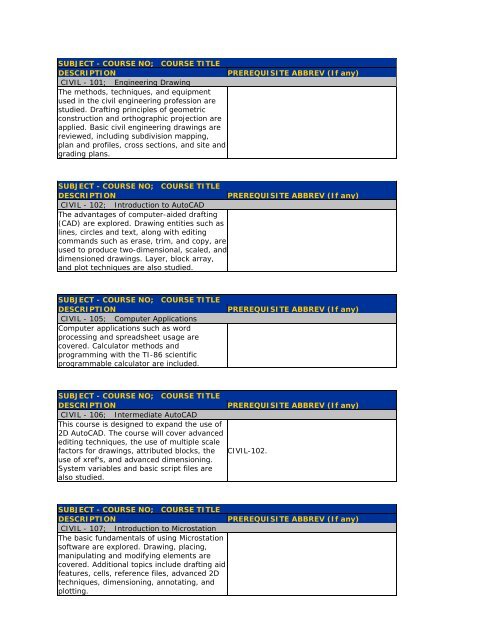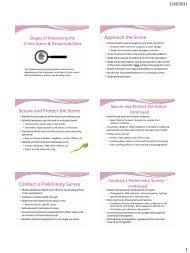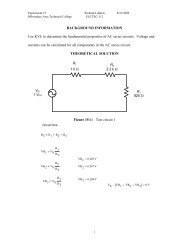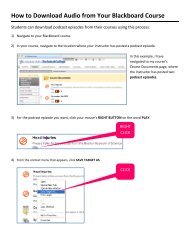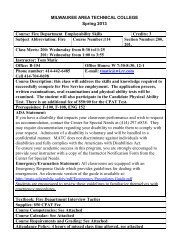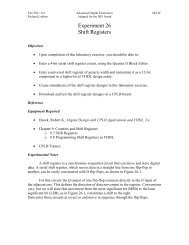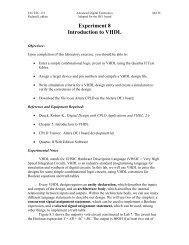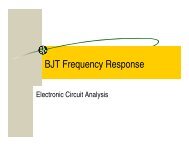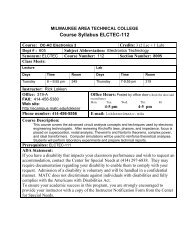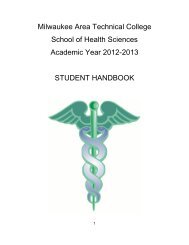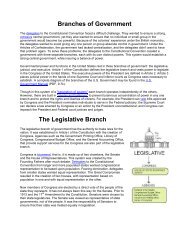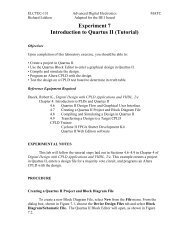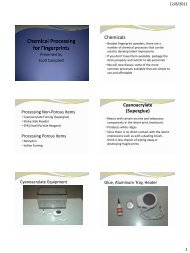SUBJECT - COURSE NO; COURSE TITLE DESCRIPTION ...
SUBJECT - COURSE NO; COURSE TITLE DESCRIPTION ...
SUBJECT - COURSE NO; COURSE TITLE DESCRIPTION ...
You also want an ePaper? Increase the reach of your titles
YUMPU automatically turns print PDFs into web optimized ePapers that Google loves.
<strong>SUBJECT</strong> - <strong>COURSE</strong> <strong>NO</strong>; <strong>COURSE</strong> <strong>TITLE</strong><br />
<strong>DESCRIPTION</strong><br />
PREREQUISITE ABBREV (If any)<br />
CIVIL - 101; Engineering Drawing<br />
The methods, techniques, and equipment<br />
used in the civil engineering profession are<br />
studied. Drafting principles of geometric<br />
construction and orthographic projection are<br />
applied. Basic civil engineering drawings are<br />
reviewed, including subdivision mapping,<br />
plan and profiles, cross sections, and site and<br />
grading plans.<br />
<strong>SUBJECT</strong> - <strong>COURSE</strong> <strong>NO</strong>; <strong>COURSE</strong> <strong>TITLE</strong><br />
<strong>DESCRIPTION</strong><br />
PREREQUISITE ABBREV (If any)<br />
CIVIL - 102; Introduction to AutoCAD<br />
The advantages of computer-aided drafting<br />
(CAD) are explored. Drawing entities such as<br />
lines, circles and text, along with editing<br />
commands such as erase, trim, and copy, are<br />
used to produce two-dimensional, scaled, and<br />
dimensioned drawings. Layer, block array,<br />
and plot techniques are also studied.<br />
<strong>SUBJECT</strong> - <strong>COURSE</strong> <strong>NO</strong>; <strong>COURSE</strong> <strong>TITLE</strong><br />
<strong>DESCRIPTION</strong><br />
CIVIL - 105; Computer Applications<br />
Computer applications such as word<br />
processing and spreadsheet usage are<br />
covered. Calculator methods and<br />
programming with the TI-86 scientific<br />
programmable calculator are included.<br />
PREREQUISITE ABBREV (If any)<br />
<strong>SUBJECT</strong> - <strong>COURSE</strong> <strong>NO</strong>; <strong>COURSE</strong> <strong>TITLE</strong><br />
<strong>DESCRIPTION</strong><br />
PREREQUISITE ABBREV (If any)<br />
CIVIL - 106; Intermediate AutoCAD<br />
This course is designed to expand the use of<br />
2D AutoCAD. The course will cover advanced<br />
editing techniques, the use of multiple scale<br />
factors for drawings, attributed blocks, the CIVIL-102.<br />
use of xref's, and advanced dimensioning.<br />
System variables and basic script files are<br />
also studied.<br />
<strong>SUBJECT</strong> - <strong>COURSE</strong> <strong>NO</strong>; <strong>COURSE</strong> <strong>TITLE</strong><br />
<strong>DESCRIPTION</strong><br />
PREREQUISITE ABBREV (If any)<br />
CIVIL - 107; Introduction to Microstation<br />
The basic fundamentals of using Microstation<br />
software are explored. Drawing, placing,<br />
manipulating and modifying elements are<br />
covered. Additional topics include drafting aid<br />
features, cells, reference files, advanced 2D<br />
techniques, dimensioning, annotating, and<br />
plotting.
<strong>SUBJECT</strong> - <strong>COURSE</strong> <strong>NO</strong>; <strong>COURSE</strong> <strong>TITLE</strong><br />
<strong>DESCRIPTION</strong><br />
PREREQUISITE ABBREV (If any)<br />
CIVIL - 132; Building Estimating<br />
Estimating techniques for civil engineering<br />
projects are covered. Students work with<br />
checklists, cost records, price lists and labor<br />
probabilities, including software usage, to<br />
make quantity surveys for material costs,<br />
labor costs, equipment costs, and overhead<br />
and profit.<br />
<strong>SUBJECT</strong> - <strong>COURSE</strong> <strong>NO</strong>; <strong>COURSE</strong> <strong>TITLE</strong><br />
<strong>DESCRIPTION</strong><br />
PREREQUISITE ABBREV (If any)<br />
CIVIL - 135; Public Works Engineering and Estimating<br />
The basic principles of planning, design,<br />
construction and operation of public works<br />
facilities, such as water, wastewater, solid<br />
waste, and transportation systems are<br />
discussed. Estimating techniques for civil<br />
engineering projects are covered.<br />
<strong>SUBJECT</strong> - <strong>COURSE</strong> <strong>NO</strong>; <strong>COURSE</strong> <strong>TITLE</strong><br />
<strong>DESCRIPTION</strong><br />
PREREQUISITE ABBREV (If any)<br />
CIVIL - 141; Statics and Strength of Materials<br />
The principles of static equilibrium are<br />
applied to free bodies. Students study the<br />
behavior of simple structures under load. The<br />
properties of the cross section are<br />
MATH-115 and MATH-116 or concurrent<br />
determined and used in the analysis of registration in MATH-116.<br />
stress, deflection and strain. Compression,<br />
tension, shear and bending stresses are<br />
analyzed.<br />
<strong>SUBJECT</strong> - <strong>COURSE</strong> <strong>NO</strong>; <strong>COURSE</strong> <strong>TITLE</strong><br />
<strong>DESCRIPTION</strong><br />
PREREQUISITE ABBREV (If any)<br />
CIVIL - 142; Structures<br />
General structural behavior with respect to<br />
live and dead loading, wind loading,<br />
earthquake loading and transfer of loads<br />
throughout a structure by diaphragms and<br />
shear walls are studied. The principles of<br />
CIVIL-141.<br />
structural steel, reinforced concrete, and<br />
timber structures are studied, including the<br />
codes of practice for each. Different types of<br />
foundations are presented and basic<br />
foundation design principles are studied.
<strong>SUBJECT</strong> - <strong>COURSE</strong> <strong>NO</strong>; <strong>COURSE</strong> <strong>TITLE</strong><br />
<strong>DESCRIPTION</strong><br />
PREREQUISITE ABBREV (If any)<br />
CIVIL - 147; Soils and Materials Testing<br />
The purpose of this course is to gain an<br />
understanding of the engineering properties<br />
of construction materials and soils. Lab tests<br />
are performed on soil, aggregates, concrete<br />
and steel. The results of these tests are then<br />
MATH-115 or concurrent registration in<br />
used to determine the strengths and<br />
MATH-115.<br />
weaknesses of each material related to their<br />
use in civil engineering. WisDOT Certification<br />
for PCCTec I/IA (Portland Cement Concrete<br />
Technician) is also available as part of this<br />
course.<br />
<strong>SUBJECT</strong> - <strong>COURSE</strong> <strong>NO</strong>; <strong>COURSE</strong> <strong>TITLE</strong><br />
<strong>DESCRIPTION</strong><br />
PREREQUISITE ABBREV (If any)<br />
CIVIL - 148; Structural Detailing<br />
This course is an introduction to detailing as<br />
performed by structural fabricators and<br />
structural engineering consultants. It includes<br />
structural steel detailing, utilizing standard<br />
shapes produced by rolling mills to make<br />
girders, beams and columns and their<br />
associated connections. Metal building<br />
detailing is also studied and compared to the<br />
conventional steel detailing. The AISC Manual<br />
of Steel Construction is used throughout this<br />
portion of the course. There is also an<br />
introduction to the detailing required for<br />
concrete structures. Poured-in-place, as well<br />
as precast structural members, standard<br />
reinforcing details and field considerations<br />
are reviewed.<br />
CIVIL-102 and CIVIL-142 or concurrent<br />
registration in CIVIL-142.<br />
<strong>SUBJECT</strong> - <strong>COURSE</strong> <strong>NO</strong>; <strong>COURSE</strong> <strong>TITLE</strong><br />
<strong>DESCRIPTION</strong><br />
PREREQUISITE ABBREV (If any)<br />
CIVIL - 155; Surveying 1<br />
The principles of surveying are presented and<br />
the use of surveying tools and instruments in<br />
the application of these principles is covered.<br />
Taping, leveling and basic total station<br />
operation use are included. The methods of<br />
measurement and the processing of<br />
measurement data are studied.<br />
<strong>SUBJECT</strong> - <strong>COURSE</strong> <strong>NO</strong>; <strong>COURSE</strong> <strong>TITLE</strong><br />
<strong>DESCRIPTION</strong><br />
CIVIL - 156; Surveying 2<br />
The principles of surveying are continued,<br />
with emphasis on traverse procedures and<br />
calculations. The theodolite, EDM, total<br />
station GPS and data collector are used for<br />
topographic and construction surveys. The<br />
uses of COGO are also covered.<br />
PREREQUISITE ABBREV (If any)<br />
CIVIL-155 and MATH-115.
<strong>SUBJECT</strong> - <strong>COURSE</strong> <strong>NO</strong>; <strong>COURSE</strong> <strong>TITLE</strong><br />
<strong>SUBJECT</strong> - <strong>COURSE</strong> <strong>NO</strong>; <strong>COURSE</strong> <strong>TITLE</strong><br />
<strong>DESCRIPTION</strong><br />
PREREQUISITE ABBREV (If any)<br />
CIVIL - 157; Route and Highway Surveying<br />
Horizontal and vertical alignment field<br />
problems and theory are covered. Geometric<br />
design, including circular horizontal curves,<br />
vertical curves, sight distance,<br />
CIVIL-156.<br />
superelevation, cross sections and earthwork<br />
is studied. Also, a roadway plan and profile<br />
are prepared.<br />
<strong>SUBJECT</strong> - <strong>COURSE</strong> <strong>NO</strong>; <strong>COURSE</strong> <strong>TITLE</strong><br />
<strong>DESCRIPTION</strong><br />
CIVIL - 158; Land Surveying<br />
The US Public Land Survey is reviewed.<br />
Minimum standards for property surveys are<br />
covered. Subdivision regulations and<br />
mapping requirements for CSM and<br />
subdivision plats are also studied. Also, the<br />
principles of control surveys, state plane<br />
coordinates, GPS, and astronomical<br />
observations are reviewed.<br />
PREREQUISITE ABBREV (If any)<br />
CIVIL-157.<br />
<strong>SUBJECT</strong> - <strong>COURSE</strong> <strong>NO</strong>; <strong>COURSE</strong> <strong>TITLE</strong><br />
<strong>DESCRIPTION</strong><br />
PREREQUISITE ABBREV (If any)<br />
CIVIL - 160; Legal Elements of Land Surveying<br />
This course covers the techniques of<br />
boundary location from the interpretation of<br />
written deeds. Principles are drawn from<br />
precedents established by the courts. CIVIL-156.<br />
Wisconsin Administrative Code A-E7 and<br />
Wisconsin Statutes Chapter 236 are<br />
reviewed.<br />
<strong>SUBJECT</strong> - <strong>COURSE</strong> <strong>NO</strong>; <strong>COURSE</strong> <strong>TITLE</strong><br />
<strong>DESCRIPTION</strong><br />
CIVIL - 161; Boundary Location<br />
The principles and practice of boundary<br />
locations are presented. The public land<br />
system is covered in detail. Principles for<br />
performing surveys will be discussed.<br />
PREREQUISITE ABBREV (If any)<br />
CIVIL-156.<br />
<strong>SUBJECT</strong> - <strong>COURSE</strong> <strong>NO</strong>; <strong>COURSE</strong> <strong>TITLE</strong><br />
<strong>DESCRIPTION</strong><br />
PREREQUISITE ABBREV (If any)<br />
CIVIL - 170; Sewer and Water Systems<br />
The principles of design and construction of<br />
water distribution, sanitary sewer and storm<br />
sewer systems are studied including the<br />
CIVIL-135.<br />
related principles of hydraulics, hydrology,<br />
and local standards. Engineering drawings of<br />
these facilities are also prepared.


